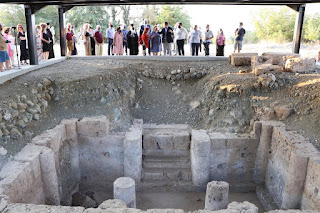LEMON BOUGATSA
750 ml (3
cups) milk
3 tsp finely grated lemon rind
1 vanilla
2 eggs
430 g (2 cups) sugar
130 g (2/3 cup) semolina
375 ml (1 ½ cup) water
62.5 ml ( ¼ cup) Metaxa brandy
3 strips lemon strips
Olive oil
10 sheets phyllo pastry
Place the milk, lemon rind and vanilla in a saucepan, and
bring to a simmer. Meanwhile, whisk the
eggs and half the sugar until pale and fluffy in a bowl. Pour the mixture into
the pan. Gradually stir in the semolina. Cook stirring until the mixture thickens into
a custard and transfer to a bowl to cool, then cover with cling film and chill.
Meanwhile, place the water, brandy, lemon rind, and remaining
sugar in a saucepan, over low heat. Cook
stirring until the sugar dissolves. Bring to a boil until the syrup reduces
and thickens. Discard the lemon rind and
set it aside to cool. Then cover and store in
the fridge.
Preheat the oven to 200 C (400 F) and line a 16x24 cm tin
with baking parchment. Brush the parchment with olive oil. Place a phyllo sheet
on the tin and brush with olive oil and repeat the procedure 3 times. Spoon in the custard and smooth the
surface. Cover with 4 pastry sheets brushed
with olive oil. Tuck the sheets into the
side of the tin to enclose the filling. Brush lavishly with oil and bake for 35
minutes or until crisp and golden. Pour
the cold syrup over the hot bougatsa, and serve with vanilla ice cream
GALCTOBOUREKO (Custard Pie)
800 g (1.8 lb) sugar
450 ml (1.9 cup) water
1 cinnamon stick
1 rind of lemon
75 g (2.6 oz) honey
For the custard:
4 eggs
200 g (7 oz ) sugar
500 ml (1 fl lb) milk
Pinch of salt
1 vanilla
170 g (6 oz) semolina
100 g (3.4 oz) butter
500 g (1 lb) phyllo pastry
220 g (7.4 oz) melted butter
Place the sugar, water, cinnamon stick, and lemon rind in a
saucepan and stir simmering until the sugar dissolves. Then add the honey and remove it from the heat and
set it aside to cool.
Preheat the oven to 180 C (350 F). Whip the eggs with half the sugar until pale
and fluffy. Place the cream, milk, and
the remaining sugar, a pinch of salt, and the vanilla and bring to a boil. Add the semolina stir constantly for 3-4
minutes until a thick custard is formed.
Remove from the heat and stir in the butter and continue beating.
Ladle all the custard into a bowl. Whip the cream and milk until cold. Mix the custard with the butter and allow to
cool.
Butter a baking dish. Place a phyllo sheet in the tin and brush with
a little butter repeat the procedure for 4 more pastry sheets. Spoon in the
custard and smooth the surface. Cover
with 5 buttered pastry sheets and tuck them neatly into the sides of the tin. Cut into 12 portions. Brush lavishly with butter
and bake for 1-1 ½ hours. Remove the galaktoboureko
from the oven and pour the cold syrup on top.
Allow to cool and absorb all the syrup before serving.
WALNUT
PIE
400 g (14 oz) sugar
400 ml (14 fl oz) water
½ a lemon
1 cinnamon stick
For the walnut pie:
250 g (8 oz) butter at room temperature, cubed
300 g (10.6 oz) sugar
4 eggs
120 ml (4.2 fl oz) milk
1 vanilla
500 g (1lb) self-rising flour
1 tsp baking powder
1 tsp cinnamon
½ tsp cloves
150 g (5.3 oz)
walnuts thickly ground
50 g (1.7 oz) almonds, roasted
150 g (5.3 oz) chocolate, thickly chopped
½ tsp salt
For the icing:
200 g (7 oz) chocolate, thickly chopped
100 ml (3.5 fl oz) cream
Boil the water, sugar, lemon, and cinnamon stick and stir.
When the sugar dissolves remove from the heat and allow to cool.
For the walnut pie, preheat the oven
to180 C (350 F). Whip butter and sugar until pale and fluffy. Add the eggs one at a time until they are
well combined.
Blend the walnuts, the cloves, the
cinnamon stick until the walnuts reach the desired size. Place the above mixture in a bowl and stir in
the flour baking powder and salt. Whip the
milk and dry ingredients for 2 minutes.
Brush a 25x32 cm tin with butter
and sprinkle with flour. Spoon in the
walnut batter and smooth the surface. Bake for 40-50 minutes. Remove from the oven and pour over the cold
syrup. Allow one hour so all the syrup
is absorbed and serve with vanilla ice cream.
VEGAN BUCKWHEAT CHOCOLATE CHIP BISCUITS
1 cup light couloured buckwheat flour
1/2 cup sugar
1/3 cup melted coconut oil
1 vanilla
1/2 tsp bicarbonate of soda
1 tsp vinegar
1/2 cup chocolate chips
Preheat oven to 180 C and line a baking tin with parchment paper. In a large bowl stir together, buckwheat flour, sugar, coconut oil, vanilla, bicarbonate of soda, and salt. Then add the vinegar which will react with the baking soda and help the biscuits rise a bit.
Fold in the chocolate chips, then with the help of a soup spoon scoop the dough into 12 mounds spaced evenly apart on the lined baking sheet. flatten each biscuit with your hands and bake until the edges are firm about 10 minutes and cool 10 minutes before serving.
PLEASE DON'T FORGET TO BE INNONULATED AGAINST THE CORONAVIRUS TO KEEP YOUR BELOVED FAMILIES AND YOURSELVES HEALTHY

















































